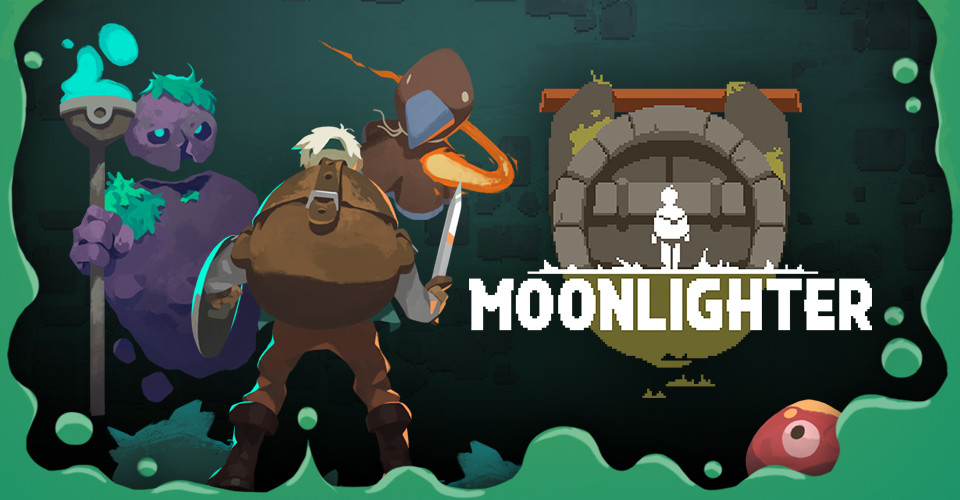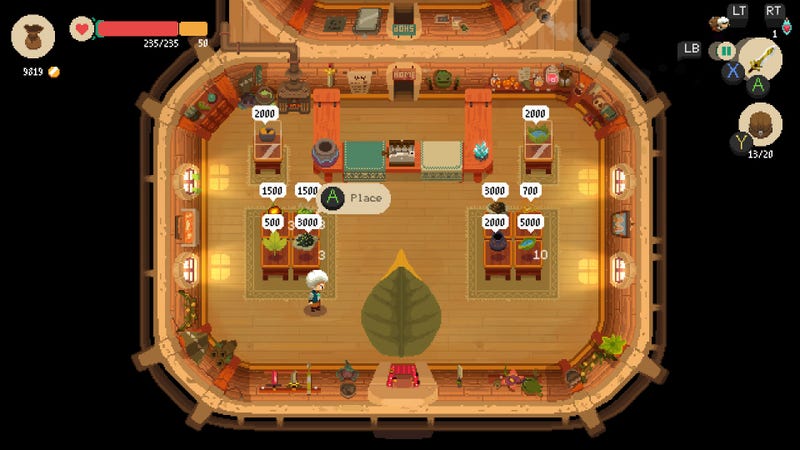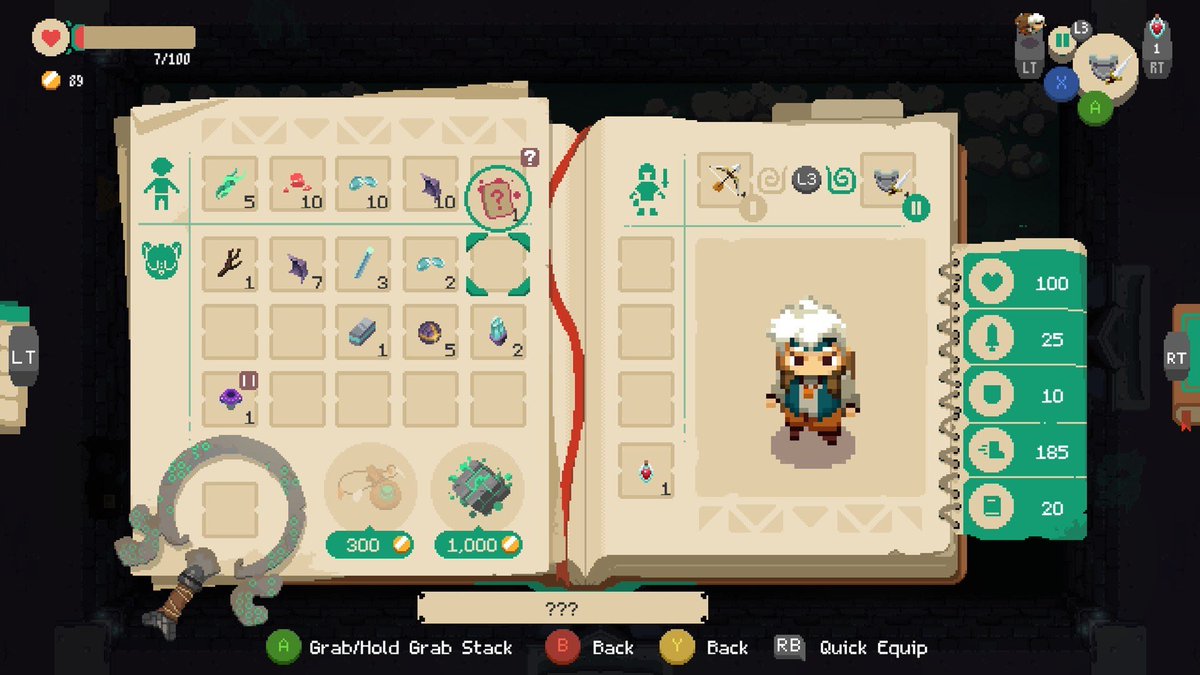
Game Club – Moonlighter
Tagged: Game Club
This month for Game Club we played Moonlighter, the Zelda-like dungeon crawler with a twist.
The twist is that you actually play a shopkeeper in a typical medieval RPG town by day and as the title implies you moonlight as a dungeon delving, treasure hunting, monster slaying adventurer at night (or during the day if you prefer). In the dungeons, you fight monsters to obtain loot both for crafting items and potions and of course for selling at your shop.
The shop, cleverly named The Moonlighter, is for the seemingly endlessly wealthy townsfolk who have an insatiable appetite for consumption of the detritus you haul back with you from your adventures in the nearby dungeons, most of which have been sealed off by said townsfolk after heroes started disappearing in them. Part of your quest is to find the keys to unlock all of the dungeons and discover the secrets hidden within.

Running the shop really adds a fun element to the game that we all agreed kept us going back for just one more run in the dungeons to find things to sell to increase our bottom line. The part of the shop that we found the most enjoyable is pricing your items and discovering just how much you can squeeze out of the customers. On each run through the dungeon you’ll discover new items, what you won’t discover is their worth to your customers. You have to play a bit of a guessing game to discover what customers are willing to pay, represented through icons, price things too low and the customers will happily take the value, too high and they’ll walk away sad and empty-handed. Each outcome costs you money but you’re not just trying to bilk the customers out of their cash you also need to be mindful of their opinion of your store and the goods you sell. If you go with low prices your shop will become popular with bargain hunters who won’t be happy if you try to start raising prices, price them too high and you won’t have any customers so the key is finding that sweet spot that keeps customers spending money at your shop while raising your bottom line.
Inventory management is also a game in itself in Moonlighter, not only due to space constraints but also because you will come across certain cursed items that will affect the items around it in your bag. The player has to do some juggling to make sure you don’t accidentally lose a valuable item due to a curse and we actually found it to be rather fun. One thing we found to be a glaring omission in a game so focused on inventory was the inability to add extra inventory slots to your bag. The game has ways of mitigating this as you get further into your adventure but a lot of grinding stands between the player and this relief and some may not have the patience for it.

You may be wondering what the point is of raking in all of that sweet gold if you also run the shop in town and that is where the crafting, upgrading and the other vendors in town come into play. As your bank statement increases you can spend it on upgrades to your shop to add more shelf space, bigger chests for storing items, decorations that make your customers happier to leave bigger tips and shop faster. You can also unlock a blacksmith to forge new weapons and an enchantress to make potions and upgrade said weapons. The vendors need more than gold to make your fancy new gear though they also need items that you’ll find in the dungeons and have to decide if you are going to put toward crafting a sweet new sword or put up for sale in your shop to make more gold.
The crafting system is fairly involved and has one of our favorite features we’ve ever seen in one of these games which is the wishlist, every RPG needs this. You can go to a crafting vendor like the blacksmith, wishlist a piece of gear you want to craft and it will put a star on the items you need to craft it so when you’ll know not to sell or junk them as you pick them up on your dungeon runs. The only drawback is that we all ended up just hoarding the starred items in the chests in the shop regardless of how many we really needed to craft the items.
Shop management and crafting aren’t the only fun part of the game though, we also enjoyed the hack and slash gameplay of the dungeon crawling portion of the game. There are four different dungeons with different themes, enemy types, and items to discover. The dungeons are top-down in the style of old-school Zelda or Binding of Isaac with an art and play style to match. Each dungeon has 4 floors, the 4th being a boss fight, which we really enjoyed. The bosses are all visually distinct and interesting and incorporate elements that challenge the skills you learned and items you acquired on the floors above.
We liked how varied the enemies are between each dungeon, not only in art style but in their attacks and abilities and that the weapons you get to use all feel very different to play and add something unique to the game. We did find the bow to be a little OP but it didn’t completely ruin the game. Your armor choices also have a big impact on how the game plays as they affect your movement speed and ability to absorb damage in a significant way. We also liked how the UI is laid out in the dungeon to keep you reminded of what each button does and to nag you to head back to town with your loot once your bag is full since if you run out of health in the dungeon you lose your items and get spit back out at the entrance empty-handed. There is a bit of a risk/reward factor with deciding to go deeper into the dungeon looking for more valuable loot but possibly dying and losing it all.

Moonlighter is a game with a lot to like but there were a few minor things we thought could have been better. For one the game has a lot of systems for the player to learn and master but doesn’t give you a lot of direction as to how they work or feedback as to whether you are doing good at them or not. For instance, a large part of running the shop is maintaining popularity with the customers in the town but there is nothing tangible in the game to tell you how you’re doing in that regard. There are customers with specific agendas that will come into your shop, indicated by icons over their head when they enter, but nothing to tell you what they mean and if you are too engaged in the chaos of running the store you might miss their indicator icon since it only appears for a few seconds. We really enjoyed the variation of weapons in the game but it was hard to tell why you would use one over the other in certain situations and why you would ever use some of the more underpowered weapons.
The guessing game of pricing your items for sale in the shop is fun but can also be frustrating and a little grindy if you have to keep running through the dungeon 4 or 5 times to finally find the sweet spot price of the items. Some kind of classification of the items (common, rare, etc.) might help a little. There’s also a top row in your bag that is used for items that will go back with you to town even if you die in the dungeon but I didn’t even realize that until the other people at the meetup pointed it out. Unfortunately, we also found the PS4 version of the game to be very buggy and not fully optimized for the hardware and would, therefore, recommend the Steam version if you have the choice. A Switch version is due very soon and seems like a great platform for this game.
Minor gripes with the UI and lack of tutorials aside the game is a ton of fun and is a welcome addition to the dungeon crawler/shop management genre that manages to blend both into an enjoyable package. The deep and unique yet familiar systems of the different parts of the game integrate nicely to feed into each other and keep you going until the end of the game and wanting more when you are done. Join us next month when we play and discuss Snake Pass.